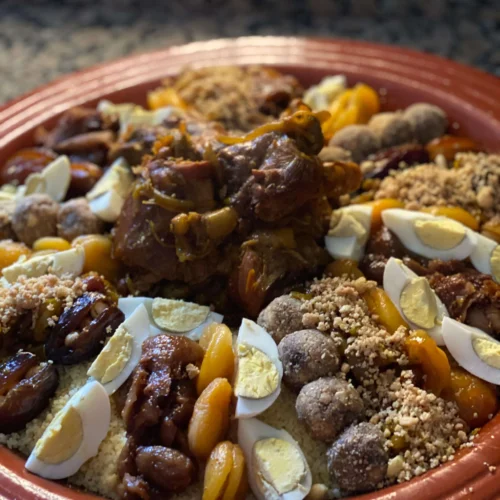Safa Recipe: A Dish That Transcends Time and Culture
Safa Recipe is a dish that transcends time, culture, and generations in Moroccan cuisine. It’s not just a meal; it’s a cherished tradition that represents hospitality, celebration, and the profound sense of community that is so deeply embedded in Moroccan culture. Served in a beautifully ornate ceramic tagine, this dish is a feast for both the eyes and the palate, combining a balance of textures, colors, and flavors that capture the essence of Morocco.
The Heart of Safa: Steamed Vermicelli
At the heart of Safa is a delicate mound of steamed vermicelli, a staple in many Moroccan kitchens. But this dish is far from simple. The vermicelli is transformed into a delicate, fluffy masterpiece, steamed to perfection, with every strand light and airy.
Aromatic Spices and Sweet Garnishes
As you approach the dish, the inviting aroma of cinnamon and sweet spices fills the air, mingling with the warm fragrance of the toasted almonds and raisins that adorn the surface. Powdered sugar, carefully sprinkled in intricate patterns, adds a touch of elegance and sweetness, while a final dusting of icing sugar creates a soft, snowy finish, making the dish even more irresistible.
Safa Recipe: A Story of Moroccan History and Culinary Tradition
Each bite of Safa tells a story, not only of ingredients but also of Moroccan history, culture, and the joy of shared moments. The combination of raisins, toasted almonds, and cinnamon is a testament to the Moroccan tradition of using a blend of sweet and savory elements, often seen in their rich and diverse cuisine. The dish evokes memories of family gatherings, festive occasions, and Moroccan hospitality, where guests are treated to a lavish spread of food that warms both the body and soul.
Safa: A Centerpiece for Moroccan Celebrations
Moroccan cuisine has long been celebrated for its ability to bring people together. Whether it’s a wedding feast, a religious holiday like Eid, or a casual gathering of family and friends, Safa plays a starring role in these celebrations. In many Moroccan households, preparing this dish is an act of love and pride, passed down through generations. The ingredients themselves speak to the diverse influences on Moroccan cooking, from the spice-rich Middle East to the fruit and nut-heavy Mediterranean region. Yet Safa remains uniquely Moroccan in its ability to balance these influences into something that is distinctly its own.
The Art of Presentation: A Visual Feast
The presentation of Safa is as important as the dish itself. The intricate patterns of powdered sugar, the glistening raisins, and the toasted almonds create a visual feast that mirrors the colorful, vibrant culture of Morocco. The dish is often served in a traditional Moroccan tagine, the ceramic cooking vessel that gives the dish its name. These tagines, with their distinctive cone-shaped lids and glazed ceramic designs, are not just functional but also works of art that represent Moroccan craftsmanship and the timeless nature of their culinary traditions.
A Moroccan Table: Enhancing the Dining Experience
The surrounding table, adorned with colorful tiles, brass utensils, and decorative ceramics, further enhances the Moroccan experience. Each item on the table adds to the authenticity of the meal, helping to transport diners to a cozy Moroccan kitchen filled with warmth, tradition, and rich aromas. The warm ambient lighting, often soft and golden, creates a sense of intimacy, inviting everyone to gather around the table and enjoy not just the food, but the joy of being in each other’s company.
Safa: A Celebration of Life and Connection
Safa is more than just a dish; it’s a celebration of life, love, and tradition. It serves as a tribute to the bonds of family and community, highlighting how food has the power to unite and create lasting connections. With its delicate balance of textures, flavors, and cultural significance, Safa is a perfect example of Moroccan hospitality and the rich culinary history that has made Moroccan cuisine one of the most revered in the world.
Savoring Safa: A Journey Through Moroccan Flavors
As you prepare and serve Safa, you are not only creating a delicious dish but also connecting to a centuries-old tradition that continues to thrive in Moroccan kitchens today. Whether you’re sharing it with loved ones or enjoying it alone, the experience of savoring this dish will transport you to Morocco, filling your senses with warmth, sweetness, and the unforgettable flavors of this iconic recipe.
Recipe: How to Make Traditional Chicken Safa Recipe
Ingredients
| Ingredient | Quantity |
|---|---|
| Chicken thighs or breasts | 6 pieces (1 kg) |
| Vermicelli | 300 grams |
| Butter | 75 grams |
| Onion | 3 large, finely chopped |
| Garlic cloves | 3, minced |
| Ground cinnamon | 2 teaspoons |
| Ground ginger | 1 teaspoon |
| Turmeric | ½ teaspoon |
| Chicken broth | 1 ½ cups |
| Olive oil | 3 tablespoons |
| Salt and pepper | To taste |
| Golden raisins | 100 grams |
| Toasted almonds | 75 grams |
| Honey (optional) | 2 tablespoons |
| Coriander or parsley | A handful, chopped |
| Icing sugar | 1-2 tablespoons |
| Cinnamon stick | 1-2 |
Preparation Steps
Steaming the Vermicelli
- Bring water to a boil in a couscoussier pot.
- Coat the vermicelli with oil in a large bowl.
- Steam the vermicelli for 35 minutes.
- Remove, moisten with salted hot water, and mix well.
- Steam again for 30 minutes, then repeat the process.
- Add raisins and steam for another 20-30 minutes.
- Toss with butter before serving.
Preparing the Almonds
- Blanch almonds in boiling water, then peel and dry.
- Lightly fry in oil until golden brown.
- Blend half of them coarsely, keeping the rest whole.
Cooking the Chicken and Sauce
- Heat olive oil in a pot and sauté chicken pieces.
- Add onions, spices, and coriander, cooking until fragrant.
- Pour in warm water and simmer until the chicken is tender.
- Remove the chicken, roast it in an oven at 200°C until golden.
- Reduce the sauce over low heat, adding honey for a richer taste.
Assembling the Dish
- Place the vermicelli on a serving plate, creating a small well in the center.
- Arrange the chicken and drizzle with the reduced sauce.
- Garnish with ground and whole almonds, cinnamon, and powdered sugar.
Nutritional Information for Safa Recipe
| Nutrient | Amount per serving |
| Calories | 450 kcal |
| Protein | 30g |
| Carbohydrates | 50g |
| Fats | 15g |
| Fiber | 5g |
| Sugar | 12g |
FAQs About Safa Recipe
What makes Safa unique in Moroccan cuisine?
Safa stands out due to its delicate balance of sweet and savory flavors, its intricate preparation process, and its cultural significance as a dish for special occasions.
Can Safa be made without meat?
Yes! A vegetarian version can be prepared using caramelized onions, chickpeas, and a variety of nuts for added texture and flavor.
What can I use as a substitute for vermicelli?
Thin pasta, such as angel hair, can be used as a substitute, though traditional Moroccan vermicelli is recommended for authenticity.
How do you store leftover Safa?
Store Safa in an airtight container in the refrigerator for up to three days. Reheat gently with a splash of water to restore its moisture.
Conclusion
Safa is more than just a dish—it is a heartfelt expression of Moroccan heritage, tradition, and hospitality. Whether enjoyed at a festive gathering or as a comforting home-cooked meal, it is a true celebration of flavors, textures, and culture. Savoring Safa is like taking a journey through Morocco, one delicious bite at a time.

Safa Recipe: Traditional Moroccan Sweet Vermicelli with Chicken
Equipment
- Couscoussier pot
- Large bowl
- Frying pan
- Oven
- Pot
- Serving Plate
Ingredients
- 6 chicken thighs or breasts (1 kg)
- 300g vermicelli
- 75g butter
- 3 large onions, finely chopped
- 3 garlic cloves, minced
- 2 tsp ground cinnamon
- 1 tsp ground ginger
- ½ tsp turmeric
- 1 ½ cups chicken broth
- 3 tbsp olive oil
- Salt and pepper to taste
- 100g golden raisins
- 75g toasted almonds
- 2 tbsp honey (optional)
- Fresh coriander or parsley, chopped
- 1-2 tbsp icing sugar
- 1-2 cinnamon sticks
Instructions
- Preparation Steps:Steam the Vermicelli:Coat the vermicelli with oil. Steam for 35 minutes, moisten with salted water, and steam for another 30 minutes. Add raisins and steam for an additional 20-30 minutes. Toss with butter.Prepare the Almonds:Blanch and peel almonds, then fry them until golden. Blend half and leave the rest whole.Cook the Chicken:Sauté chicken in olive oil, add onions, spices, and coriander. Simmer with chicken broth until tender. Roast chicken in the oven at 200°C until golden. Reduce sauce and add honey for sweetness.Assemble the Dish:Place the steamed vermicelli on a serving plate, top with chicken, sauce, almonds, raisins, and a dusting of powdered sugar and cinnamon.

